Former Israeli Prime Minister Golda Meir was known for wearing sturdy orthopedic shoes. They served a functional purpose, taking her from cabinet meetings to meeting US presidents at the White House to her very own kitchen. They were so practical, in fact, that they earned their own name — the “Golda shoes.” And they soon became a symbol of sensibility and honor, even being worn by female soldiers in the Israeli army until 1987.
Women’s shoes, like Golda’s, have remained symbols of status and aesthetic expression throughout history. In an exhibit at the Rishon Lezion Museum, they emphasize empowerment and reflect the struggle of the Israeli woman’s fight for equality — in a touching and satirical way.

“In Her Shoes” is an exhibition marking 100 years of women’s suffrage in Rishon Lezion, one of the first Hebrew settlements in Israel. The women of the Rishon Lezion colony were the first of the Hebrew settlements to attain political equality in 1919.
That year, Nehama Pohatchevsky, a farmer and writer who championed the struggle for equal rights for women, was active in public and fought for society’s disenfranchised populations, succeeded to gain the right to vote for women in the Moshava. The Moshava refers to the first of the settlements of the First Aliyah in 1882, or what is today a part of the central Israeli city of Rishon Lezion. (Most Western states extended voting rights to women around this time: the 19th amendment to the US constitution was ratified in 1920.)

Curator Yona Shapira told NoCamels on a tour of the exhibit that it “combines history and art” and aims to give the evolution of women’s shoes “a new dimension.” But at its core, the exhibit is a way to understand the woman’s role in Israeli society and her struggle for equality, by being “in her shoes.”
The exhibit’s host artist and presenter is Kobi Levi, an acclaimed Israeli shoe designer whose “wearable sculptures” are works of art. So much so that he began sparking the interest of celebrities like Lady Gaga, who wore his shoes in a music video, and Whoopi Goldberg, who contacted him to add to her shoe collection. Most recently, he created shoes specifically for Israeli singer Netta Barzilai who wore them as part of her look at the Eurovision Song Contest final in 2018, where she won first place for Israel.

“We take the core subject that we deal with — women’s suffrage and women’s history in culture and society — and [with shoes] we tell different anecdotes that show the progress in history,” Levi tells NoCamels.
The exhibition was held in cooperation with the Bezalel Academy of Art and Design, where Levi is a faculty member in the Jewelry and Fashion department. Many of the designs on display were created by Bezalel graduates like Ella Gendler and Shelly Satat-Kombor, now head of Bezalel’s Jewelry and Fashion department.
Levi also chose shoes from one of Israel’s most popular shoe designers, Shani Bar, a fellow Bezalel graduate, and designer Ganit Goldstein, a recent graduate of Bezalel known for her 3D printed clothes and shoes that balance digital techniques with hand-made and traditional ones.
Designers like Tal Uriel of Uriel Studio and Talia Lev-Ari created shoes specifically for the exhibit.
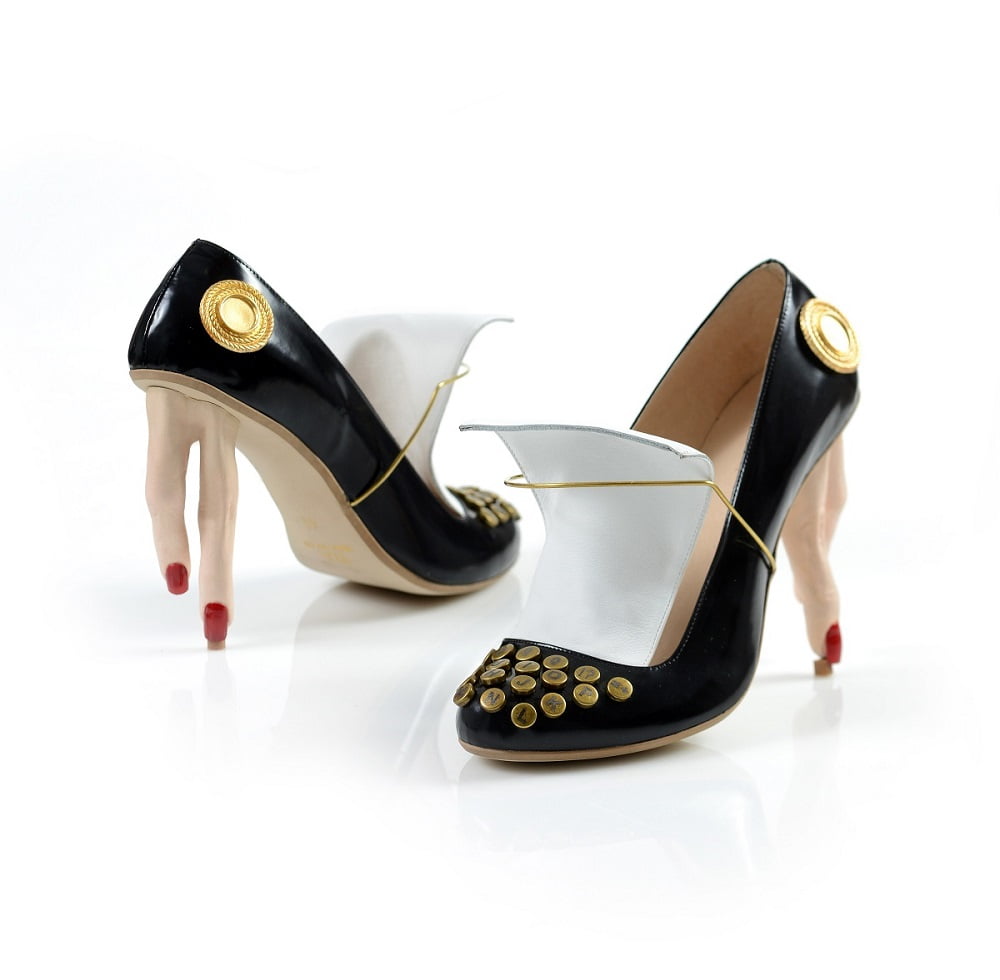
“Half of the exhibit here is mine and then I collected from different designers,” says Levi, “I felt it was more important to have a group exhibition because there’s a lot of talent here. I focus on shoes but so many people design so many great things. It’s easier to bring people in when it’s more focused. And so many people connect with design.”
SEE ALSO: These Boots Are Made For Lady Gaga: Kobi Levi Takes The Shoe Industry By Storm
The exhibit begins with large photographs of women who were pioneers of Hebrew feminism in Rishon Lezion, including Nehama Pohatchevsky, who championed the struggle for equal rights for women and Hana Levin, the first woman to become a city mayor in the State of Israel.
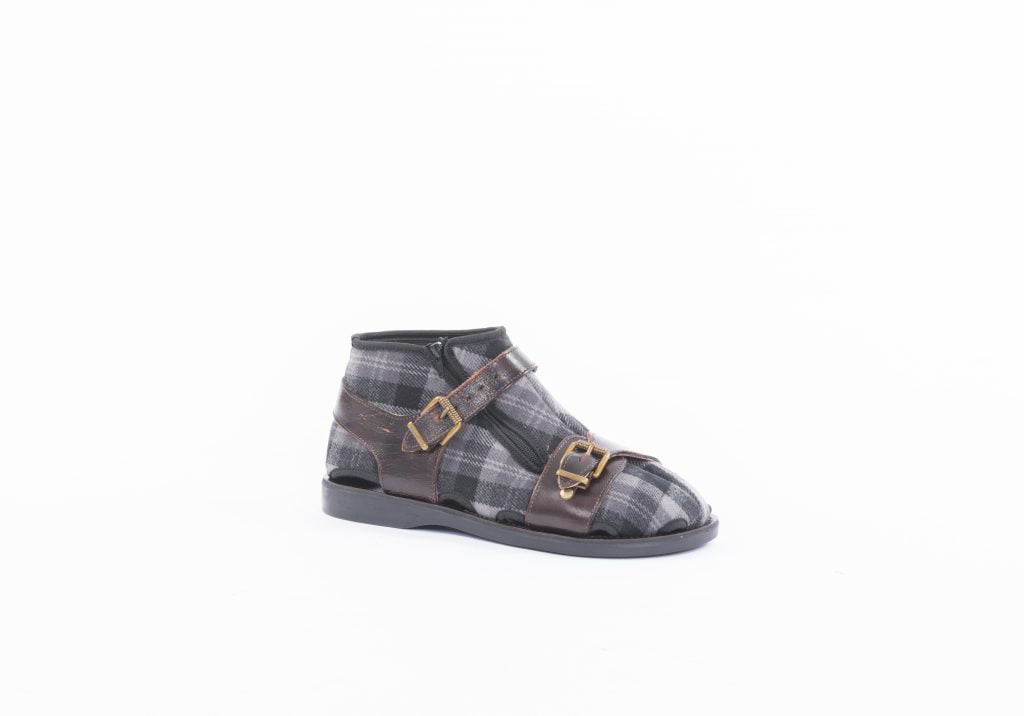
The photos are accompanied by a display featuring a Kippi sandal, designer Yarden Florence Deddi’s vintage 1970s reproduction of the classic Israeli “naal bayit” (slipper) named after the character Kipi, a porcupine who wore giant house slippers on Israel’s version of Sesame Street. There are also Kippi boots by Shelly Satat-Kombor as a student (she is now the current head of Jewelry and Fashion at Bezalel) and an elongated modern version of the Biblical sandal created by designer Roni Burrell. Nearby, a replica of the “Golda shoes” of the 1960s and 70s by Rona Doron are showcased next to IDF training shoes which were the shoes that replaced Golda shoes for women in the Israeli army.
In the main exhibit, a sneaker stiletto Levi cheekily calls “High-End Sneakers” stands out for its juxtaposition of comfort and style. Shoes in the shape of boxing gloves by Keren Bet Esh indicate the woman’s struggle to fight for their rights.

The “Tie-d” shoes by Shani Bar have neckties painted on them to reflect the changing roles of men and women. The “Cinderella” shoe by Ella Gendler is a unique take on the glass slipper that looks both striking and painful to wear.
Sign up for our free weekly newsletter
SubscribeA shoe by Levi in the shape of a rolling trolley often used by senior men and women to go food shopping at the shuk is meant to reflect on the preconceived notion of women as the grocery shoppers of the family. Another shoe has synthetic hair on one side and the shape of a cone on the other to mirror Madonna’s iconic cone bra and high ponytail look from her Blonde Ambition tour in the early 90s.

“She has a lot of things to say. She brings up a lot of issues for discussion,” Levi says, referring to Madonna’s influence on the fight for women to have a voice.
A shoe shaped like a white coffee pot with coffee spilling out is supposed to draw on the stereotype of the office secretary preparing coffee in the workplace. In the 70s, during a strong feminist movement, more than one secretary was fired for not agreeing to do this.
Levi explains his inspiration for the shoe. “We chose this design to be here because there’s a story in the 70s in the US about a legal secretary that was asked to make coffee for her boss. It was a very stereotypical, gender role thing in the office. Now it’s a little bit old fashioned. She said no, it’s not her job. And she was fired.”
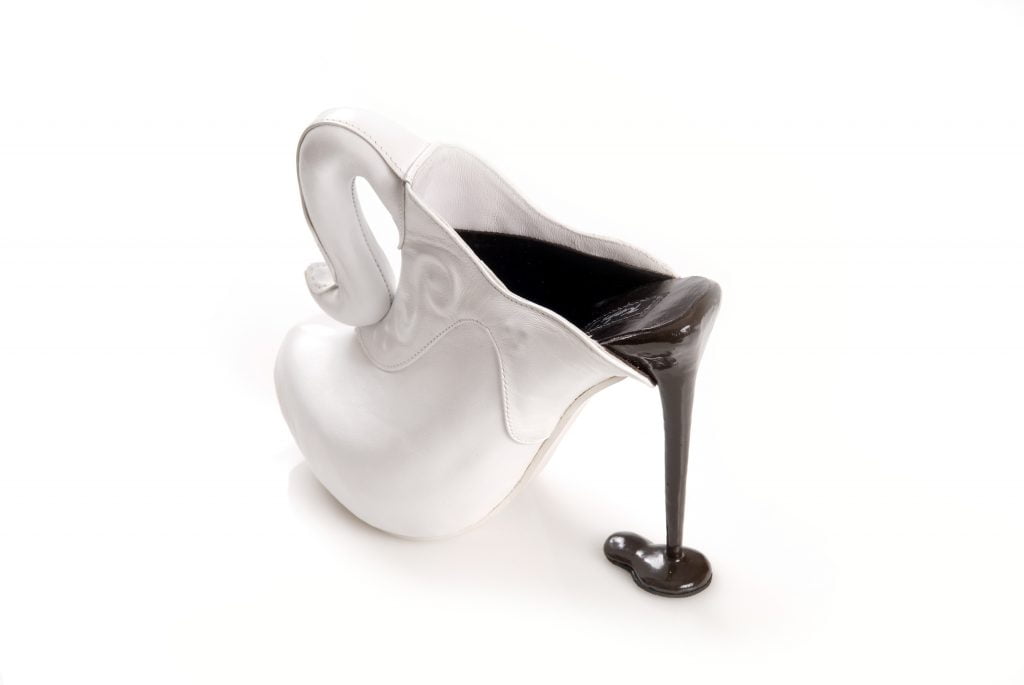
Ganit Goldstein’s creations seek to transform conventional fashion through a unique mix of art and technology, while still focusing on traditional fashion design and hand-made techniques. Her shoes in the exhibit are footwear from her graduation project as a student at Bezalel. The shoes, called “HomeWORK” are hand made tapestry on a 3D printed base, and seek to showcase the shift from traditional women’s roles at home to a more professional role in the workplace.
SEE ALSO: Israeli Designer Wows International Audiences With 3D Printed Sustainable Garments, Shoes
Levi says he was immediately drawn to Goldstein’s work and chose it for the exhibition because it had a lot of sewing, which has historically and stereotypically been seen as a woman’s job, combined with a modern 3D printing technique.
“It’s a shoe, but it’s kind of a skeleton that I’m designing in 3D software, so I can remake my own craft on it. It’s kind of the balance between digital machines and handmade that are combined together to build the final result,” Ganit explains, “It’s not meant for wearing. It’s the combination that I’m trying to achieve.”
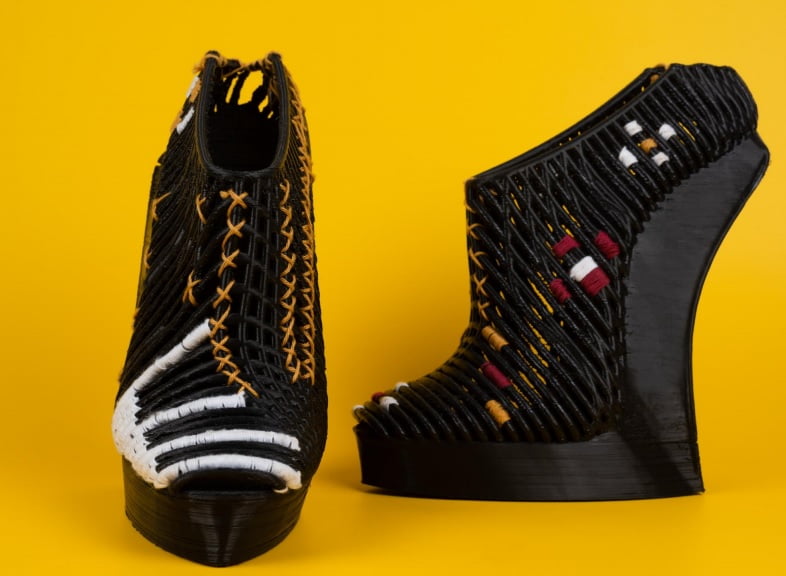
The designer recently launched a collection based on this graduation project, to find the symmetry between two different worlds. “Between the Layers” consists of seven 3D printed outfits and six pairs of shoes, which Goldstein designed in this view of “bridging modern technologies and traditional fashion design.” The garments and footwear are made with thermoplastic polyurethane (TPU) and Polylactic acid (PLA).
“Embroidery and digital software are the opposite of each other,” she says, “It’s the sewing or the sketching for me. I’m not seeing the 3D software as my aim.”
Rounding out the exhibit are two memorable images of Golda Meir. One is her portrait as an assemblage made entirely of miniature Golda shoes on wood by Dalia Matmon. The other is a 3D collage by Hanoch Piven of Golda in the kitchen. The profile is made of a dough with hair of steel wool and a nose made of poultry, to immortalize Golda in the kitchen. The profile’s chin rests on a “Golda shoe.”
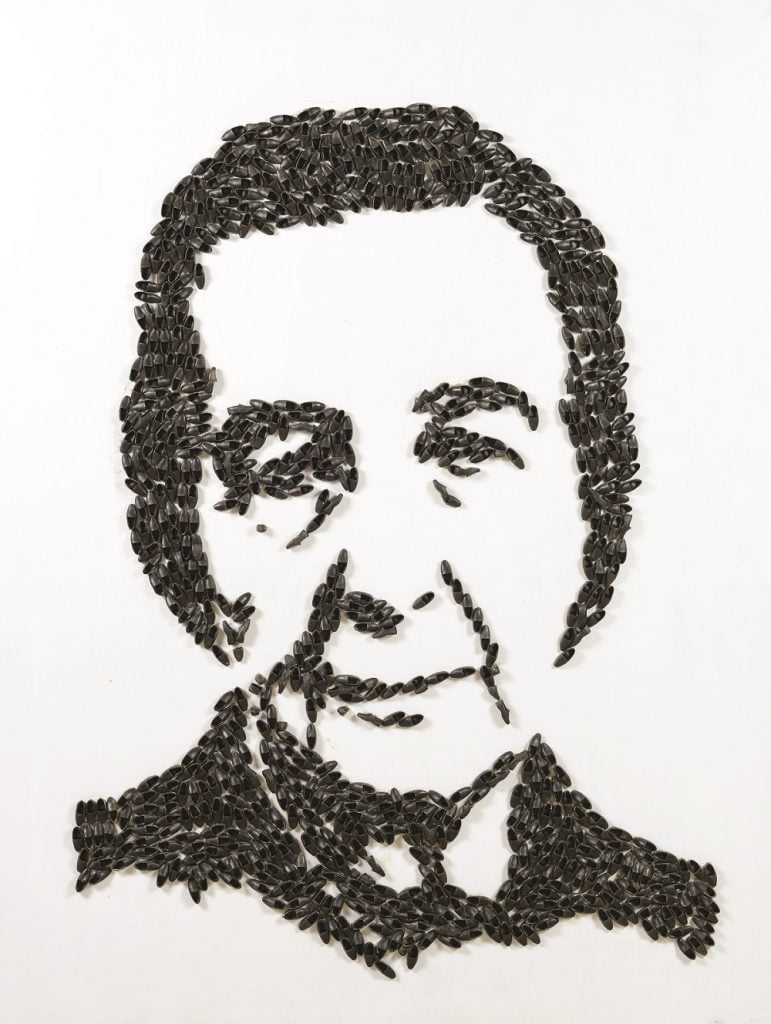
Golda Meir toyed with traditional gender roles. She was quoted as saying that Israel’s first Prime Minister David Ben-Gurion once described her as “the only man’ in his cabinet.” At the same time, she was not opposed to inviting members of the Knesset to her home where she would prepare coffee and cake. It became known as her “kitchen cabinet” which is a term still used in Israeli politics today.
Meir didn’t mind taking on the role of leader or homemaker or grandmother when the occasion called for it. Though she did not specifically fight for women’s equality, she focused on it through her actions. Therefore, it is sensible to say that she is a worthy addition to the exhibit. As sensible, as – say – the shoes on her feet.
In Her Shoes exhibition closes in March 2020. The Rishon LeZion Museum, 2 Ahad Ha’am St, 03-9598862www.rishonlezion-museum.org.il
Related posts

Rehabilitation Nation: Israeli Innovation On Road To Healing

Israeli High-Tech Sector 'Still Good' Despite Year Of War


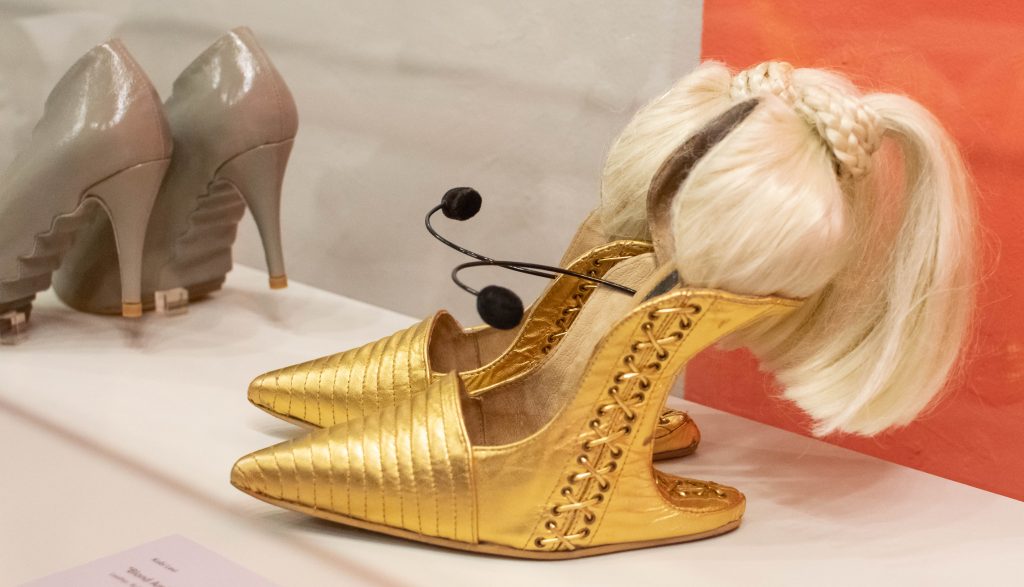


Facebook comments